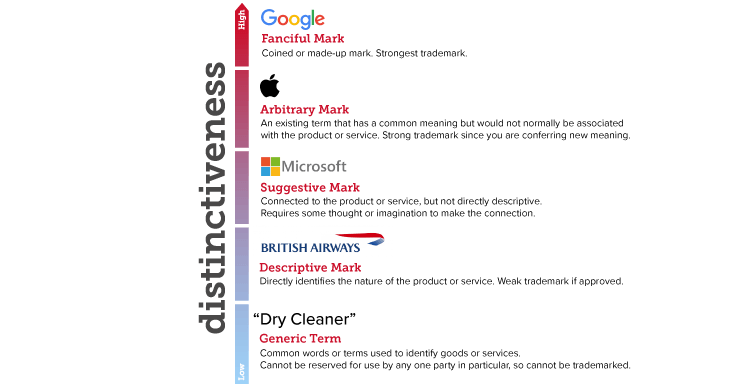Rebranding? Think like an IP attorney
Name and brand identity are often amongst the most valuable assets a business will ever have. It makes sense to protect these marks to the extent legally possible. While there are often conflicting priorities between marketing and legal teams, the overriding goal—creating distinctive assets—tends to be shared. Incorporating legal considerations into your marketing up front can save a lot of heartache later on.
From a legal perspective, the strength of a potential trademark tends to depend on where it falls on a spectrum of distinctiveness, from generic terms (least distinctive) to fanciful marks (most distinctive). Distinctiveness here is the opposite of descriptiveness, so the more descriptive you want your brand to be about what it does, the less distinctive it will be. This is where marketing and legal leaders sometimes clash.
However, many of the most powerful brands are “fanciful” (use made-up words, e.g., Google), “arbitrary” (existing terms in a new context, e.g., Apple) or “suggestive” (connected to the product, but not directly descriptive, e.g., KitchenAid). They become strong trademarks because of their distinctiveness, and strong brands because of powerful associations and meaning built around the brand through the product, service, experience and image they provide. Marketing and legal teams should be aligned in the goal of achieving distinctive meaning around the brand.
Best in branding: The brand as an extension of the self

You should always seek professional legal counsel when considering trademarks. A distinctive mark will more likely be approved and will be easier to legally defend if approved. But most importantly, from a brand perspective, it will be easier to carve a differentiated position in the marketplace and in the minds of consumers. Trademarks exist to prevent confusion. A strong trademark is more easily identified with your brand, and all your efforts to build associations and meaning around your brand will more easily flow back to you.
As you consider new brand marks going forward, how will you ensure your marketing and legal teams are aligned?
